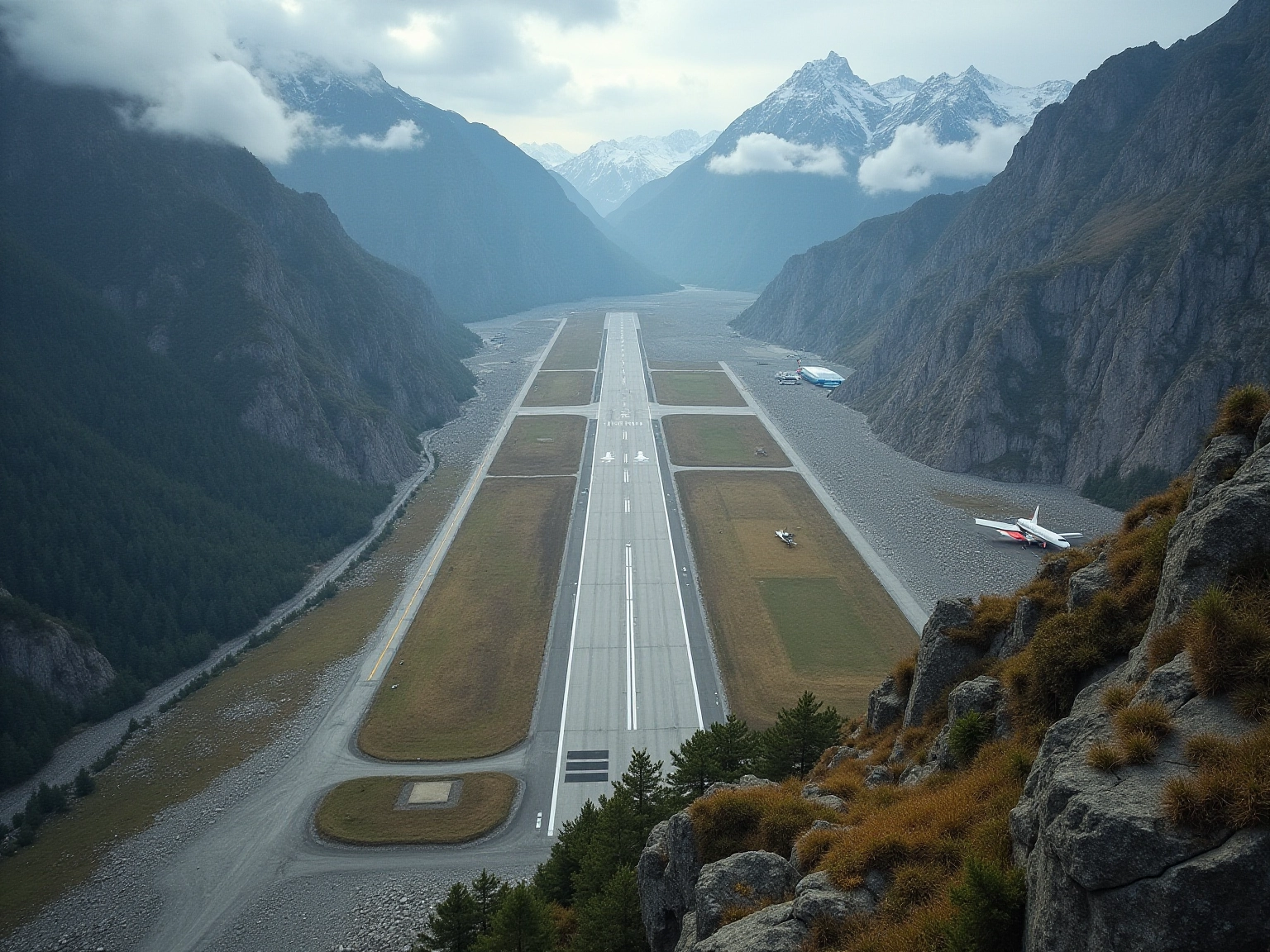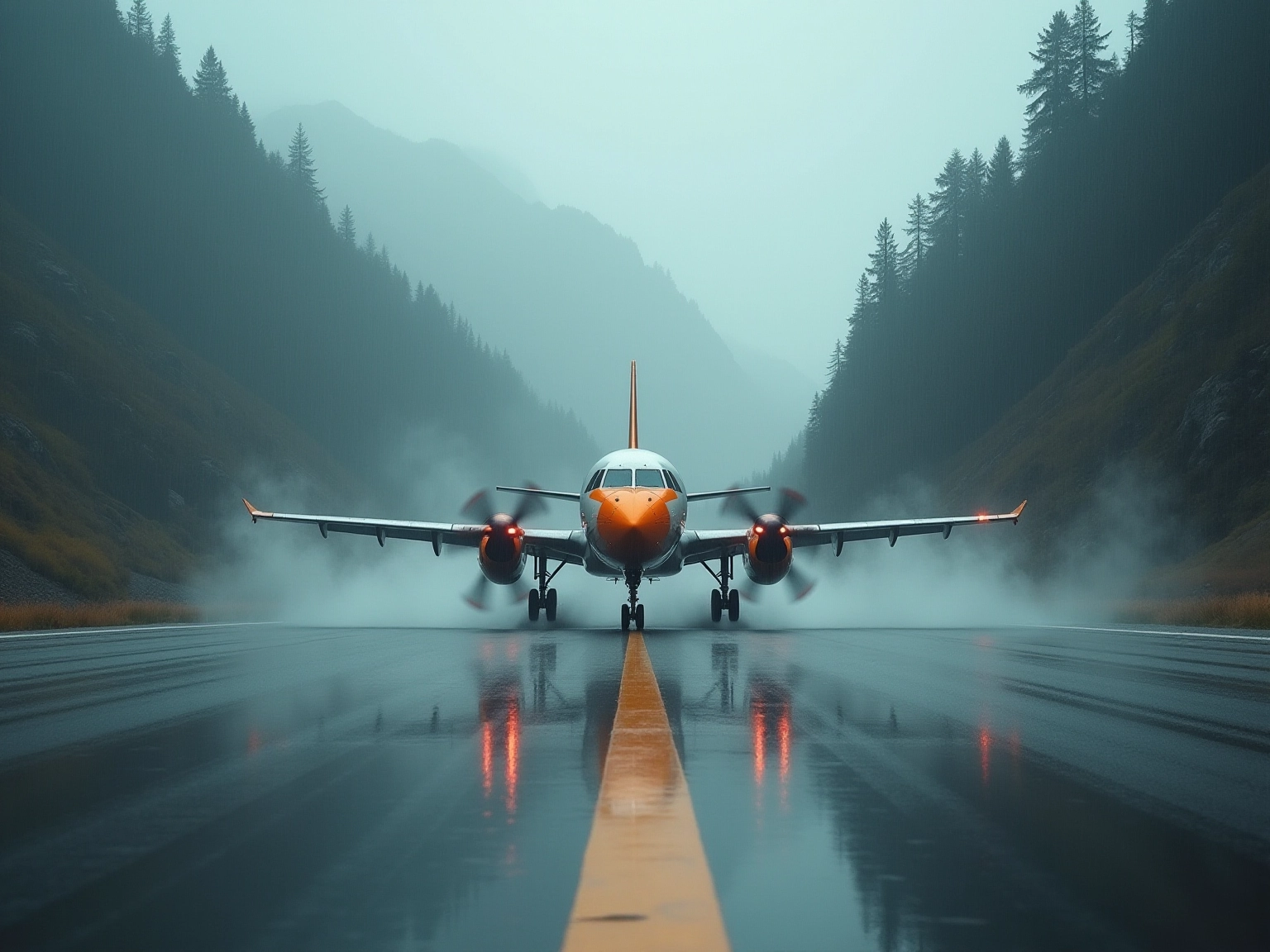Overview
Have you ever thought about the risks that come with flying into the world’s deadliest airports? This article dives into some of the key challenges you might not have considered, like hazardous terrain and unpredictable weather. Not to mention, specialized pilot training is a must!
Take Lukla and Courchevel, for example. These airports really highlight how geographical and weather-related hurdles, combined with strict training requirements, contribute to their dangerous reputations. It’s fascinating to see how these factors impact the overall safety of air travel, isn’t it? So, if you’re planning a trip to one of these thrilling destinations, make sure to keep these challenges in mind!
Key Highlights:
- Hazardous airports are marked by short runways, challenging terrain, unpredictable weather, and limited approach paths.
- Lukla Airport in Nepal and Courchevel Altiport in France are cited as some of the deadliest due to their difficult landings.
- Key criteria for identifying dangerous airfields include accident data, training requirements for pilots, and runway conditions.
- Geographical factors, like mountainous terrain, significantly impact safety, as seen at Paro International Airport in Bhutan.
- Weather conditions, such as fog and high winds, complicate landings, exemplified by Toncontin International Airport in Honduras.
- Pilot challenges include managing steep descents and sudden weather changes, requiring advanced skills and situational awareness.
- Training for pilots operating in high-risk environments is critical, as nearly half of aviation accidents occur during takeoff or landing.
- Case studies highlight the risks and appeal of notorious airports, with a noted decline in fatalities suggesting improvements in safety measures.
Introduction
In the world of aviation, some airports truly stand out—not just for where they take you, but for the unique challenges they pose to pilots and passengers alike! These so-called “dangerous airports” often feature:
- Short runways
- Unpredictable weather
- Tricky terrain
Making every landing a test of skill and precision. Picture this: from the perilous heights of Lukla Airport in Nepal to the steep slopes of Courchevel Altiport in France, the characteristics that define these airports reveal a fascinating mix of geography, meteorology, and human expertise. As air travel becomes more accessible, it’s essential to understand the risks tied to these high-stakes environments. After all, we want the thrill of adventure to come without compromising safety, right?
Define Dangerous Airports: Key Characteristics and Criteria
Hazardous airfields are often defined by several key factors that contribute to their risk levels. Think about short runways, challenging terrain, unpredictable weather conditions, and limited approach paths. For instance, Lukla in Nepal and Courchevel in France are considered some of the deadliest airports due to their dangerous landings resulting from elevated altitudes and surrounding mountainous terrain!
When it comes to identifying a hazardous airfield, standards often include examining:
- Accident data
- Training requirements for aviators
- The physical attributes of the facility itself—like runway length and surface conditions
Understanding these traits is essential for both pilots and passengers, as they highlight the inherent dangers linked to specific air travel locations. So, the next time you’re planning a trip, keep these factors in mind to ensure a safer journey!

Examine Risk Factors: Geography, Weather, and Terrain Challenges
Did you know that the geography of the deadliest airport can really shape its safety? This is especially true for those in mountainous regions near the deadliest airport. Take Paro International Airport in Bhutan, for instance. It faces steep approaches and limited visibility, which makes arrivals quite the challenge! Weather conditions can make things even trickier. Imagine fog, heavy rain, and high winds all impacting flight operations. It’s no wonder that Toncontin International Airport is considered the deadliest airport in Honduras due to its notorious rapidly changing weather patterns, which create turbulent conditions that complicate safe landings. As noted by Rodríguez-Sanz et al., “Wind conditions and low visibility have the most substantial impact, with additional delays observed during high temperatures and specific cloud formations.”
But it doesn’t stop there! Terrain-related challenges at the deadliest airport, including short runways and nearby obstacles, require pilots to have specialized training and experience to navigate these high-risk environments effectively. Research has shown that visibility issues are a leading cause of fatal helicopter accidents, accounting for a significant portion of incidents. This really highlights the critical need for improved operational strategies in such locations.
By understanding these geographical and meteorological factors, you can see how stakeholders can optimize operations and enhance overall safety. Plus, exciting developments like the NextGen Weather Processor are making waves in aviation! This technology provides enhanced atmospheric products, assisting in air traffic management and contributing to safer operations by delivering timely information on hazards. So, whether you’re a traveler or just curious about aviation, there’s so much to discover about how geography and weather play a role in keeping our skies safe!

Explore Pilot Challenges: Navigating High-Risk Landings
Landing at the deadliest airport can be quite the adventure for aviators, as it presents a range of challenges that require advanced skills and sharp situational awareness. Imagine managing steep descents, reacting to sudden weather changes, and executing precise maneuvers in tight spaces!
Take Lukla Airport, for example—its short runway demands a swift descent through rugged mountains, showcasing just how talented aviators need to be. They must skillfully use both instruments and visual cues to navigate safely, especially when visibility is low.
A recent incident involving a Saurya Airlines Bombardier CRJ-200ER shortly after takeoff from Kathmandu Tribhuvan Airfield in July 2024, which tragically resulted in the loss of 18 lives, highlights the real dangers of arriving at what is considered the deadliest airport. This heartbreaking event underscores the vital need for aviators to be prepared for the unique challenges that the deadliest airport environments present, as training and certification for those operating in these high-risk areas are no walk in the park. They focus on equipping pilots with the skills necessary to tackle the distinct challenges posed by the deadliest airport.
This extensive training is crucial—did you know that nearly half of all aviation accidents between 1983 and 2019 occurred during takeoff or landing? It really emphasizes how important it is to be ready to enhance passenger safety.
Beyond technical skills, aviators must also be aware of common pitfalls, like running low on fuel or executing low-altitude maneuvers, which can lead to avoidable accidents. The mix of airplane configuration changes, navigation, communication with Air Traffic Control, and varying weather conditions significantly heightens the risk of crashes during these critical flight phases.
By leveraging modern technology and adhering to best practices in flight planning and fuel management—just like the case studies suggest on preventing common pilot errors—pilots can greatly reduce these risks, ensuring safer arrivals at some of the world’s most challenging airstrips.

Case Studies of Notorious Airports
Air travel hubs can be quite notorious for their challenging conditions, highlighting the fundamental hurdles of aviation. Take Lukla Airport, which is often dubbed the deadliest airport in the world. Nestled in the Himalayas, it boasts a runway of just 527 meters, flanked by steep cliffs that pose significant risks for landings. Did you know that from 2009 to 2018, the peak year for airplane accidents in Nepal was 2016, with four incidents reported? It really underscores the historical dangers associated with the deadliest airport in the world, Lukla. Yet, there’s some good news! Over the years, there has been a steady decline in fatalities related to airplane accidents, suggesting that improvements in safety measures are making flying a bit safer. Fast forward to 2025, and recent events at Lukla have once again highlighted these risks, with tricky weather conditions making arrivals a challenge.
Now, let’s hop over to Courchevel Altiport in France, which is famous for its short, sloped runway. It demands precise landings, especially when the weather turns sour. The unique topography and challenging approach make it a thrilling spot for adventurous aviators and travelers alike.
And how about Princess Juliana International Airport in St. Maarten? Here, aircraft swoop low over a beach, creating a stunning sight for both travelers and beachgoers. This dramatic approach not only heightens the excitement of flying but also showcases the unique charm of the terminal.
These examples reveal the risks associated with the deadliest airport air travel hubs while also highlighting their appeal for adventurous tourists. As Karen LeBlanc beautifully puts it, “By combining expert storytelling with practical travel advice, The Design Tourist empowers readers to explore the world with a creative lens.” The blend of breathtaking scenery and the thrill of navigating challenging landings makes these airports a must-visit for those seeking extraordinary travel experiences!

Conclusion
Exploring dangerous airports reveals a captivating yet sobering reality about air travel! Think about it: short runways, unpredictable weather, and challenging terrains all underscore the risks pilots and passengers face. Airports like Lukla and Courchevel Altiport showcase unique challenges that demand not just advanced flying skills but also a keen understanding of geographical and meteorological factors.
Landing at these airports is no small feat! It requires a high level of training and situational awareness from pilots. The unfortunate incident involving Saurya Airlines serves as a stark reminder of the stakes involved in aviation. It reinforces the necessity for rigorous preparation and adherence to best practices. Did you know that a significant percentage of aviation accidents occur during landing or takeoff? This highlights the critical need for enhanced safety measures in these high-risk environments.
Ultimately, while the allure of flying into such extraordinary airports draws adventurous travelers, it’s essential to recognize and respect the challenges they present. With continued advancements in technology and training, the aviation industry can strive to improve safety and mitigate risks. This way, the thrill of adventure doesn’t come at the cost of safety! Understanding these dynamics enriches your travel experience, allowing you to appreciate the skill and expertise that go into navigating some of the world’s most dangerous airports.
Frequently Asked Questions
What factors contribute to an airfield being classified as hazardous?
Hazardous airfields are often defined by several key factors including short runways, challenging terrain, unpredictable weather conditions, and limited approach paths.
Can you provide examples of hazardous airfields?
Yes, examples of hazardous airfields include Lukla in Nepal and Courchevel in France, which are considered some of the deadliest airports due to their dangerous landings caused by elevated altitudes and surrounding mountainous terrain.
What standards are used to identify a hazardous airfield?
Standards for identifying a hazardous airfield typically include examining accident data, training requirements for aviators, and the physical attributes of the facility, such as runway length and surface conditions.
Why is it important to understand the traits of hazardous airfields?
Understanding these traits is essential for both pilots and passengers as they highlight the inherent dangers associated with specific air travel locations, contributing to safer journey planning.


































